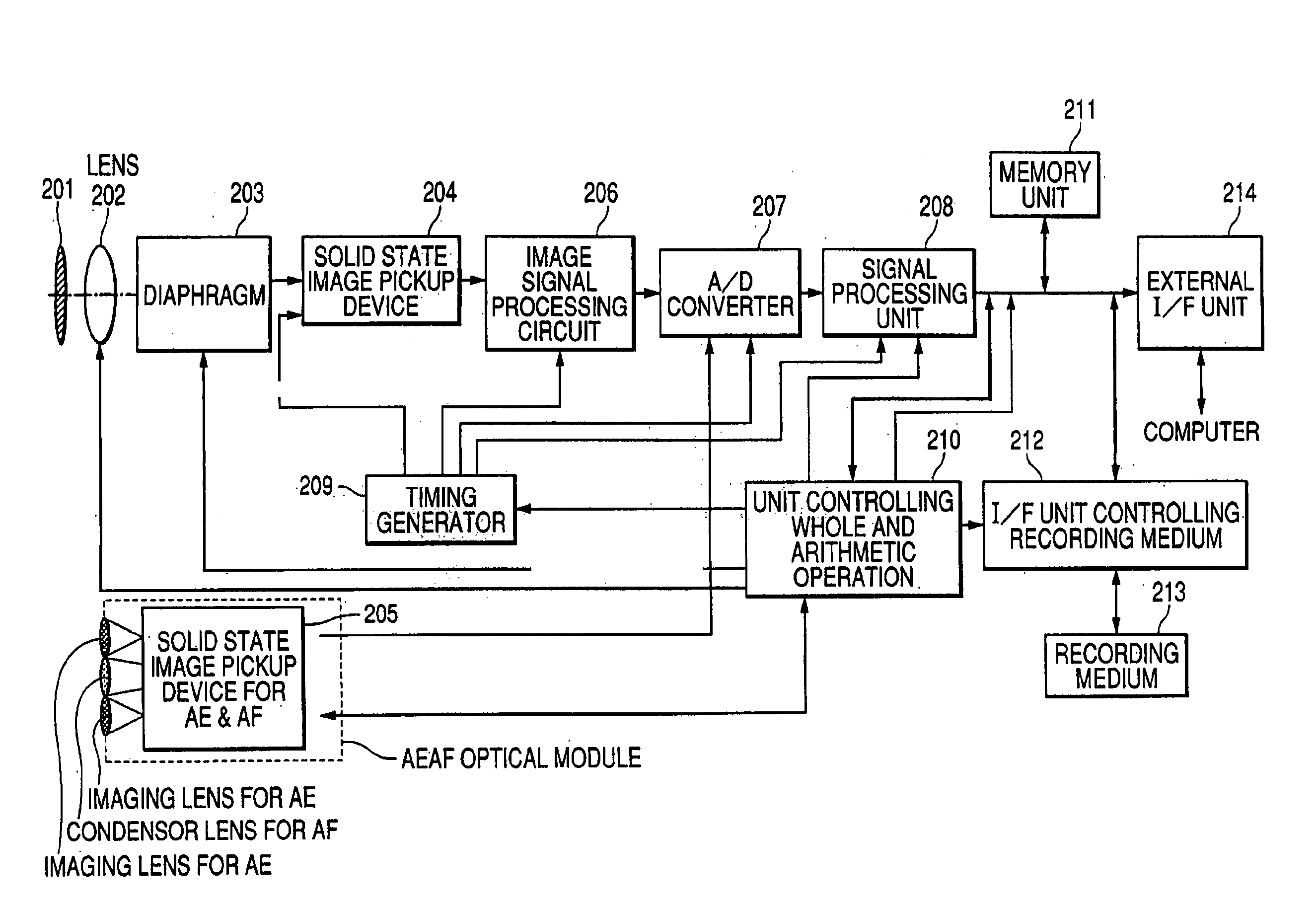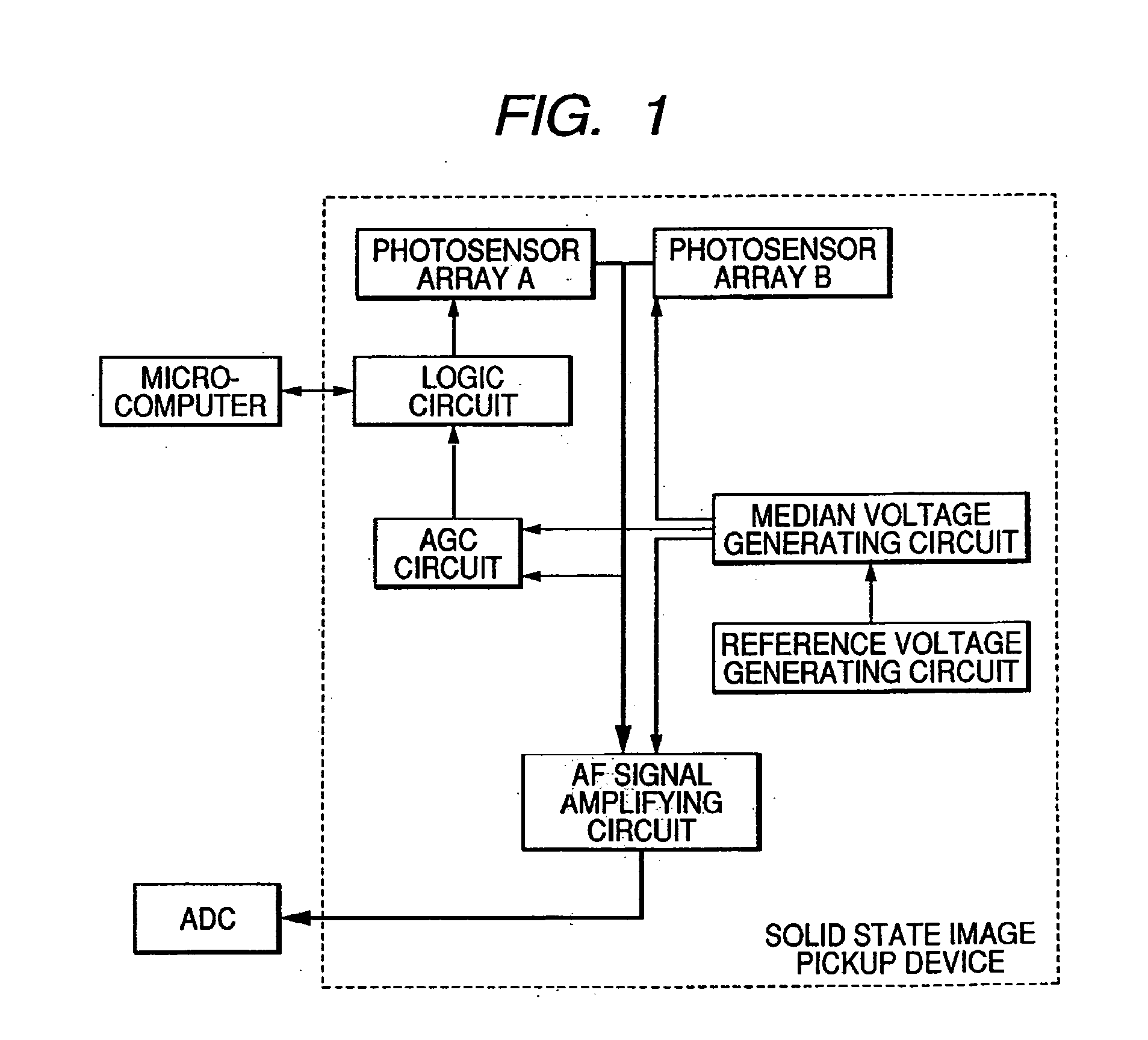Solid state image pickup device and camera
a pickup device and solid-state image technology, applied in the direction of cameras, instruments, printers, etc., can solve the problems of increasing chip area and power consumption, not being able to detect focus for low-contrast objects, etc., to achieve the effect of increasing the capture rate and the success rate of focus detection
- Summary
- Abstract
- Description
- Claims
- Application Information
AI Technical Summary
Benefits of technology
Problems solved by technology
Method used
Image
Examples
first embodiment
[0028]An embodiment of the present invention is described with reference to FIG. 1. FIG. 1 is a block diagram showing a solid state image pickup device for detecting focus according to a first embodiment of the present invention and an external control block.
[0029]In FIG. 1, photosensor arrays are image pickup elements each for outputting an image signal of an object. The photosensor arrays are provided in a pair, and a distance between peak signals outputted from both of the photosensor arrays is obtained to detect focus. An AF signal amplifying circuit level-shifts an output from the photosensor array and applies a gain to the level-shifted output. A reference voltage generating circuit generates a band gap reference voltage. A median voltage generating circuit generates, based on the band gap reference voltage, median voltages such as an accumulation end voltage and an output reference voltage in the solid state image pickup device. An auto gain control (AGC) circuit monitors a m...
second embodiment
[0044]FIG. 6 is a diagram showing an AF signal amplifying circuit according to a second embodiment of the present invention.
[0045]In FIG. 6, an explanation is omitted for the components similar to those of FIG. 2. FIG. 6 shows a switch 17 which operates at the same timing of the switch 3.
[0046]The AF signal amplifying circuit according to the second embodiment can follow the operation sequence same as that of the first embodiment. The AF signal amplifying circuit according to the second embodiment is different from that of the first embodiment in that the switch 17 is additionally provided to obtain a unity gain outputted from the operational amplifier. A difference between the unity gain outputted from the operational amplifier and the output reference voltage is recorded to thereby eliminate a DC offset held by the operational amplifier.
[0047]In the second embodiment, the operational amplifier and a variable resistor are used to form the noninverting amplifier. However, the noninv...
third embodiment
[0048]FIG. 7 a diagram showing an AF signal amplifying circuit according to a third embodiment of the present invention.
[0049]In FIG. 7, an explanation is omitted for the components similar to those of FIG. 2. FIG. 7 shows variable capacitors 18 and 19 for determining an amount of gain, and a switch 20 which operates at the same timing of the switch 3. According to the first and second embodiments, a current flows between the output terminal of the operational amplifier and the input terminal 4. This current is driven by the operational amplifier and therefore relates to current consumption of the operational amplifier. Accordingly, resistance values of the variable resistors 5 and 6 of FIG. 2 must be raised in order to reduce the current consumption of the operational amplifier. However, a resistor element generally has a parasitic capacitance owing to a layout. Therefore, a greater resistance value increases an area for a layout, which increases the parasitic capacitance. As a res...
PUM
 Login to View More
Login to View More Abstract
Description
Claims
Application Information
 Login to View More
Login to View More - R&D
- Intellectual Property
- Life Sciences
- Materials
- Tech Scout
- Unparalleled Data Quality
- Higher Quality Content
- 60% Fewer Hallucinations
Browse by: Latest US Patents, China's latest patents, Technical Efficacy Thesaurus, Application Domain, Technology Topic, Popular Technical Reports.
© 2025 PatSnap. All rights reserved.Legal|Privacy policy|Modern Slavery Act Transparency Statement|Sitemap|About US| Contact US: help@patsnap.com



